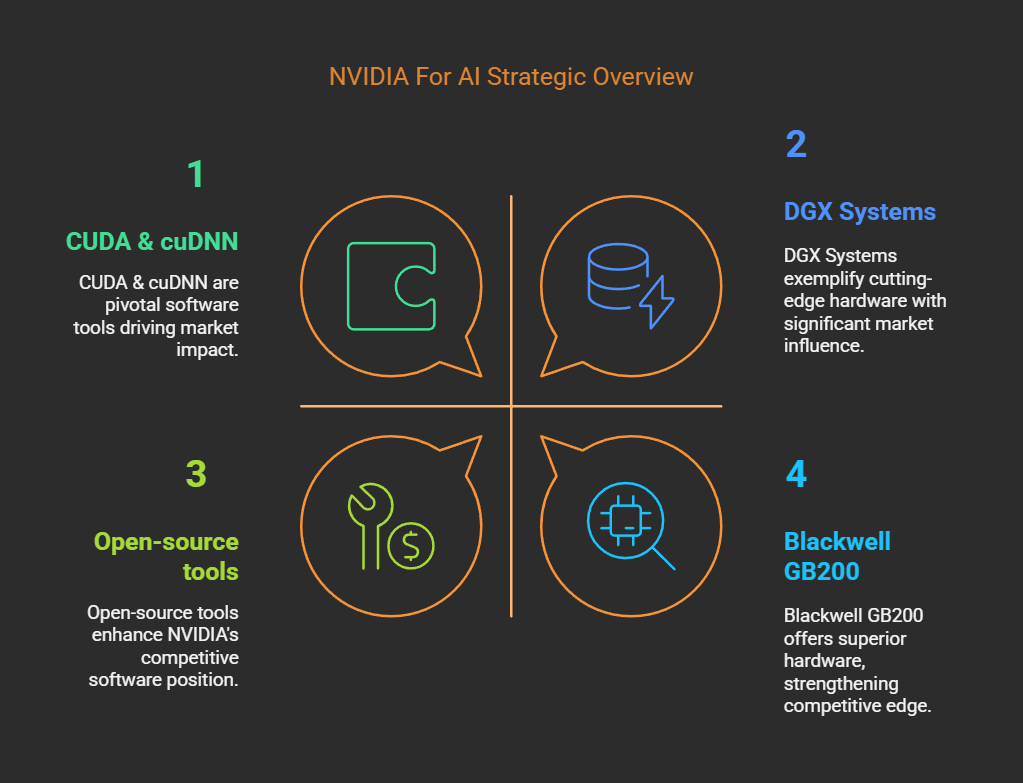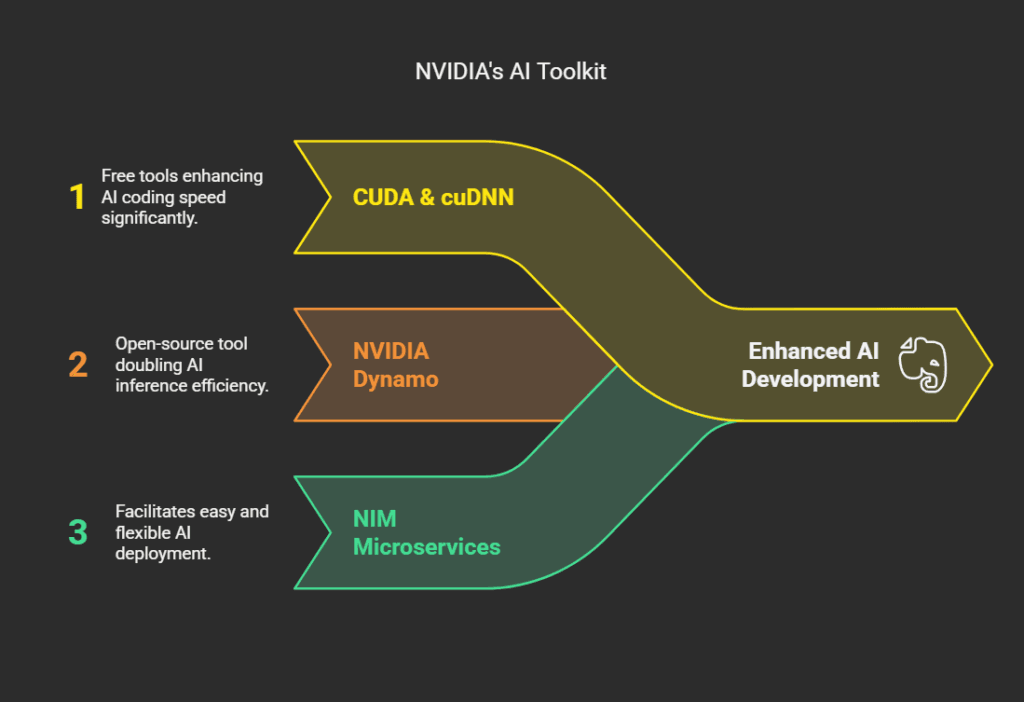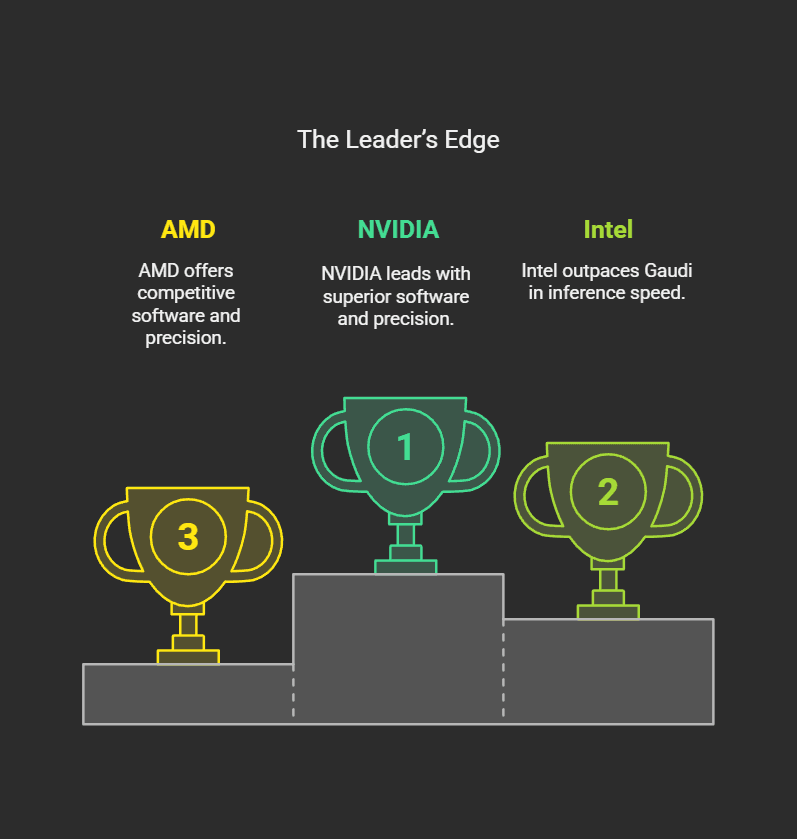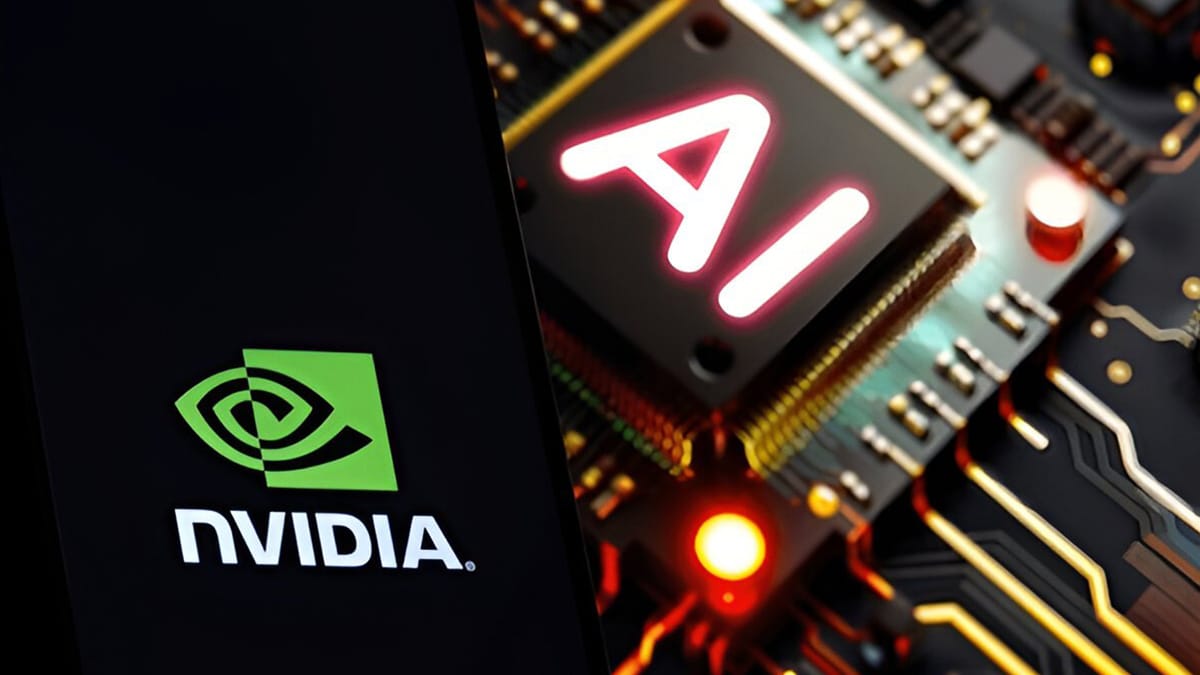Artificial intelligence (AI) is no longer a sci-fi dream—it’s here, reshaping industries from healthcare to gaming. At the heart of this revolution stands NVIDIA, a tech giant that’s become synonymous with cutting-edge AI solutions. With NVIDIA for AI, businesses, developers, and innovators are mastering technology with stunning precision, thanks to powerful GPUs, groundbreaking software, and a vision to push boundaries in 2025. Whether you’re training massive models or running lightning-fast inference, NVIDIA’s toolkit is the go-to choice. Let’s dive deep into how NVIDIA for AI drives the future, why it matters, and what it means for you.

NVIDIA’s Legacy in AI: From Graphics to Genius
NVIDIA started as a graphics card maker in 1993, but its pivot to AI has been legendary. By the early 2000s, its GPUs—built initially for rendering video games—proved perfect for the parallel computing demands of AI. Today, NVIDIA for AI is a powerhouse, blending hardware, software, and expertise to tackle everything from self-driving cars to generative AI chatbots.
The turning point came with CUDA, NVIDIA’s programming platform, which was launched in 2006. It lets developers tap GPUs for general-purpose computing, sparking an AI boom. Fast forward to 2025, and NVIDIA for AI is leading with its Hopper and Blackwell architectures, designed from the ground up to handle AI’s toughest challenges. This isn’t just about faster chips—it’s about precision, scalability, and making AI accessible to all.

The Hardware That Powers NVIDIA For AI
When you think of NVIDIA for AI, think of GPUs – graphics processing units that crunch numbers like champs. But these aren’t your old-school gaming cards. Here’s what’s driving the magic in 2025:
1. Hopper H200: Speed Meets Scale
Introduced in 2023 and refined by 2025, the H200 GPU is a beast for training AI models. With 141GB of HBM3e memory and a bandwidth of 4.8 terabytes per second, it’s built to handle trillion-parameter models—like those powering ChatGPT rivals. For NVIDIA for AI, the H200 means faster training times and stunning precision in tasks like natural language processing or image recognition.
2. Blackwell GB200: Inference King
Unveiled at GTC 2025 on March 18, the Blackwell GB200 takes NVIDIA for AI to new heights. It’s a dual-GPU monster with 240GB of memory, optimized for inference—the stage where AI models make predictions or generate outputs. NVIDIA claims it’s 30 times faster than Hopper for heavy reasoning tasks, making it a precision tool for real-time AI applications like autonomous vehicles or medical diagnostics.
3. DGX Systems: All-in-One AI Powerhouses
For big players, NVIDIA’s DGX systems bundle GPUs into supercomputers. The DGX GB200, launched alongside Blackwell, packs eight GPUs into one box, delivering exascale performance (a quintillion calculations per second). It’s NVIDIA for AI at its most muscular, perfect for enterprises scaling AI across data centers.
These chips aren’t just fast—they’re smart, with features like Transformer Engine (for language models) and FP8 precision (for efficiency). That’s why NVIDIA for AI is the backbone of modern tech.
Software: The Brain Behind NVIDIA For AI
Hardware alone doesn’t win the race—software ties it all together. NVIDIA for AI shines with a suite of tools that make AI development a breeze:

1. CUDA and cuDNN: The Developer’s Dream
CUDA remains the foundation, letting coders harness GPU power with ease. Paired with cuDNN—a library for deep neural networks—it speeds up training and inference for everything from image classifiers to voice assistants. In 2025, NVIDIA for AI will keep these tools free and updated, ensuring developers can master AI precision without reinventing the wheel.
2. NVIDIA Dynamo: Open-Source Efficiency
Launched at GTC 2025, NVIDIA Dynamo is an open-source inference framework that’s turning heads. It splits workloads across GPUs, optimizes memory, and cuts costs—doubling performance on Hopper and boosting it 30-fold on Blackwell. For NVIDIA for AI, it’s a gift to the community, making precision inference accessible to all.
3. NIM Microservices: Plug-and-Play AI
NVIDIA’s NIM (NVIDIA Inference Microservices) lets businesses deploy AI models fast. Think pre-built APIs for tasks like text generation or object detection, all tuned for NVIDIA GPUs. In 2025, NVIDIA for AI will use NIM to bring enterprise-grade precision to startups and giants alike.
Real-World Impact of NVIDIA On AI
The proof is in the pudding—or, in this case, the projects. NVIDIA for AI is everywhere in 2025:
- Healthcare: NVIDIA’s Clara platform uses AI to analyze medical scans with pinpoint accuracy, speeding up diagnoses. The GB200’s inference power cuts processing time, saving lives with precision.
- Automotive: Self-driving cars from Tesla and Waymo lean on NVIDIA for AI to process camera and radar data in real time. The DRIVE platform, powered by Hopper, ensures split-second decisions.
- Entertainment: Studios like Pixar tap NVIDIA GPUs to render photorealistic films faster. AI-driven upscaling in games via DLSS 3 delivers stunning visuals with minimal lag.
Posts on X from March 20, 2025, show the hype—users rave about Blackwell’s “insane” speed and Dynamo’s “game-changing” efficiency. Companies like AWS and Google Cloud are integrating NVIDIA for AI into their services, proving its reach.
Why NVIDIA For AI Matters in 2025
AI isn’t slowing down, and neither is NVIDIA. With models growing larger—think trillion-parameter behemoths—precision and efficiency are critical. NVIDIA for AI meets this demand head-on, offering tools that scale without skyrocketing costs. Its open-source efforts, like Dynamo, democratize access, while its hardware pushes the limits of what’s possible.
Take inference, for example. A Blackwell GPU can handle 30 times more tokens per second than last-gen tech, per NVIDIA’s GTC claims. That’s not just speed—it’s precision at scale, whether you’re running a chatbot or analyzing climate data. For businesses, this translates to lower bills and happier users. For developers, it’s a free pass to experiment and innovate.
NVIDIA For AI vs the Competition
NVIDIA isn’t alone in the AI race, but it’s ahead. Here’s how NVIDIA for AI stacks up:
- AMD: AMD’s Instinct MI300X GPUs compete on price and power, but NVIDIA’s software ecosystem (CUDA, Dynamo) gives it an edge in developer support and precision.
- Intel: Intel’s Gaudi chips target AI training but lag in inference speed compared to Blackwell. NVIDIA for AI wins with broader compatibility.
- Google TPU: Google’s TPUs shine in its cloud but are less flexible outside it. NVIDIA’s open approach makes it king for diverse use cases.
NVIDIA for AI blends raw power with a rich toolkit, making it the precision leader in 2025.

Benefits for Everyday Users
You don’t need a PhD to see the perks of NVIDIA for AI:
- Faster Tech: From gaming to apps, AI-driven features load quicker and look better.
- Cost Savings: Open-source tools like Dynamo cut expenses for small teams.
- Green Impact: Efficient GPUs use less energy—a win for the planet.
- SEO Edge: Content creators can leverage AI to churn out keyword-rich material fast.
Imagine a streamer upscaling video with DLSS or a blogger using NIM for instant drafts. That’s NVIDIA for AI in action.
Challenges to Watch
It’s not all roses. NVIDIA GPUs are pricey—Blackwell systems can cost millions for enterprises. The setup can be complex, too, and coding chops for CUDA or Dynamo are needed. And while NVIDIA for AI dominates, supply chain hiccups (noted on X, March 19, 2025) could slow rollouts. Still, NVIDIA’s community support and free resources ease the pain.
The Future of NVIDIA For AI
NVIDIA for AI is set to soar. Plans for 2025 include tighter AI Enterprise integration and broader NIM rollouts. Next-gen chips—rumored for 2026—could double down on precision and power. As AI shapes our world, NVIDIA’s role as a master tech driver is locked in.
Final Thoughts
NVIDIA for AI is more than a tagline—a promise delivered with stunning precision. From Hopper’s training to Blackwell’s inference edge, NVIDIA is mastering AI in 2025. Its free tools, like Dynamo, and robust hardware make it a force for businesses, developers, and dreamers. Ready to harness AI’s future? NVIDIA for AI is your key to unlocking it.
FAQs:
What does NVIDIA For AI offer developers in 2025?
NVIDIA for AI gives developers a goldmine of tools—free software like CUDA and Dynamo, plus GPUs like Hopper and Blackwell. Launched at GTC 2025, Dynamo doubles inference speed on Hopper, making it a precision powerhouse for coding AI apps, chatbots, or analytics. It’s all about faster, more intelligent development without significant costs.
How does NVIDIA For AI improve everyday tech?
NVIDIA for AI powers smoother, sharper tech—like DLSS in games or real-time diagnostics in healthcare. Its Blackwell GB200, out in 2025, cuts inference lag, so apps respond instantly. For users, it means better experiences; for creators, it’s a chance to build cutting-edge solutions with precision.
Is NVIDIA For AI worth the investment for small businesses?
Yes, if you’re in AI-heavy fields like content or analytics. NVIDIA for AI offers free tools like Dynamo, saving cash, but top-tier GPUs (e.g., DGX systems) are pricey. Small teams can start with affordable Hopper cards and scale up, mastering AI precision on a budget.
